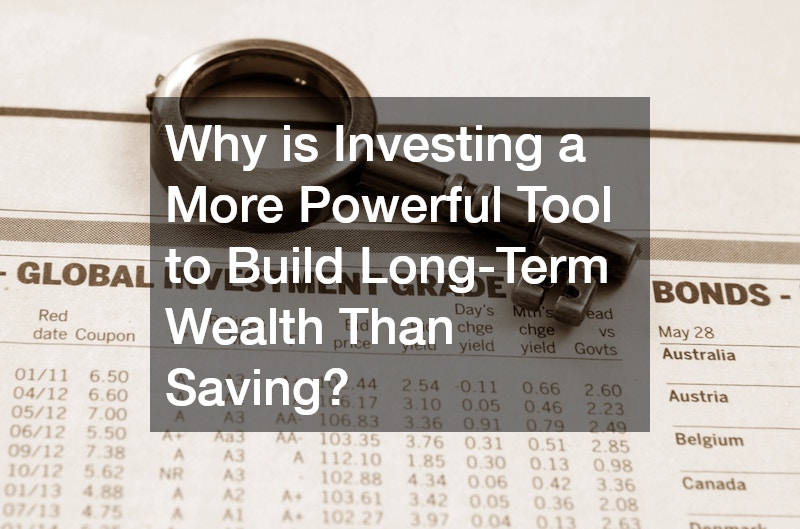
For those serious about achieving financial independence, understanding the distinction between saving and investing is critical. While both play roles in personal finance, investing offers the exponential growth potential that saving alone cannot match. In a world where inflation eats into purchasing power and retirement horizons stretch longer than ever, relying solely on a savings account can mean missing out on significant wealth-building opportunities. So, why exactly is investing a more powerful tool to build long-term wealth than saving? Let’s dive deep.
The Basics: How Do Saving and Investing Really Differ?
At a glance, saving and investing may seem similar. Both involve putting aside money for future use. However, their mechanics, purposes, and outcomes are vastly different.
- Saving typically involves low-risk methods such as stashing money in a bank account or a certificate of deposit (CD). It’s safe but offers minimal returns.
- Investing, on the other hand, means putting money into assets like stocks, bonds, real estate, or mutual funds with the expectation of earning returns over time.
While saving is essential for short-term goals and emergencies, it does not provide the kind of growth needed for retirement, financial freedom, or legacy building.
Why Investing Beats Saving in the Long Run
Investing isn’t just about taking risks—it’s about making your money work harder for you. For finance-savvy individuals, understanding the power of compound growth is essential to appreciating why investing has the upper hand.
When you invest:
- You earn returns on your returns, not just your principal.
- Over time, compounding accelerates growth in a way that saving can’t match.
- Even small, consistent investments can grow into significant sums with enough time.
Let’s break down why investing is more powerful:
1. Higher Potential Returns
- Average interest on a high-yield savings account: 3–4% annually.
- Average long-term return of the S&P 500: ~7–10% annually after inflation.
The difference in returns may seem small in percentage terms, but it makes a massive difference over decades. For example, $10,000 invested with a 7% return annually grows to nearly $76,000 in 30 years, while the same amount saved at 3% yields just over $24,000.
2. Beating Inflation
Inflation typically ranges between 2 and 3% per year. If your savings are earning less than inflation, you’re essentially losing purchasing power over time. Investing in inflation-beating assets like equities helps you preserve and grow wealth in real terms.
3. Diversification and Risk Management
Modern investing tools like index funds, ETFs, and robo-advisors make it easier than ever to diversify your investments and manage risk efficiently. Savvy investors balance risk and reward to optimize growth while protecting their portfolios.
What About Risk? Isn’t Investing Dangerous?
It’s a fair question. Investing does come with risk—market downturns, volatility, and economic uncertainties can lead to losses in the short term. However, finance-savvy individuals understand a crucial concept: time in the market beats timing the market.
Long-term investors benefit from:
- Market recoveries after recessions or crashes.
- Dollar-cost averaging, which helps manage volatility.
- Portfolio rebalancing, which minimizes exposure to overvalued assets.
Risk in investing can be mitigated with strategy, education, and discipline. Saving, while “safe,” comes with the hidden risk of stagnation and lost opportunity.
When Should You Save and When Should You Invest?
It’s not a matter of choosing one over the other—they both have their place in a sound financial plan. Think of saving as the foundation and investing as the growth engine.
Save for:
- Emergency funds (3–6 months of expenses)
- Short-term goals (within 1–2 years)
- Planned purchases (vacation, car, wedding)
Invest for:
- Retirement
- Wealth accumulation
- Children’s education
- Long-term financial independence
This strategic balance of saving vs investing gives you both security and growth.
Why Is Investing a More Powerful Tool to Build Long-Term Wealth Than Saving?
At the heart of it, investing is powerful because it leverages time, compound interest, and market performance to grow wealth far beyond what saving can accomplish. While saving is linear and static, investing is exponential and dynamic.
Let’s recap the key advantages of investing:
- Compound growth turns small sums into significant wealth over time.
- Market performance often outpaces inflation, protecting your wealth.
- Diversification allows for tailored risk and return strategies.
- Automated tools and platforms make investing more accessible than ever.
Finance-savvy people understand that sitting on cash may feel safe, but it won’t help them retire comfortably or build generational wealth. Investing provides the roadmap to scalable financial success.
Final Thoughts: The Long Game Wins
Building long-term wealth isn’t about avoiding risk at all costs—it’s about taking smart, calculated risks over time. By allocating your resources wisely between saving and investing, you can create a resilient and prosperous financial future.
Whether you’re planning to retire early, fund a child’s education, or achieve complete financial independence, investing offers the trajectory you need. Saving gives you a cushion, but investing builds the castle.


